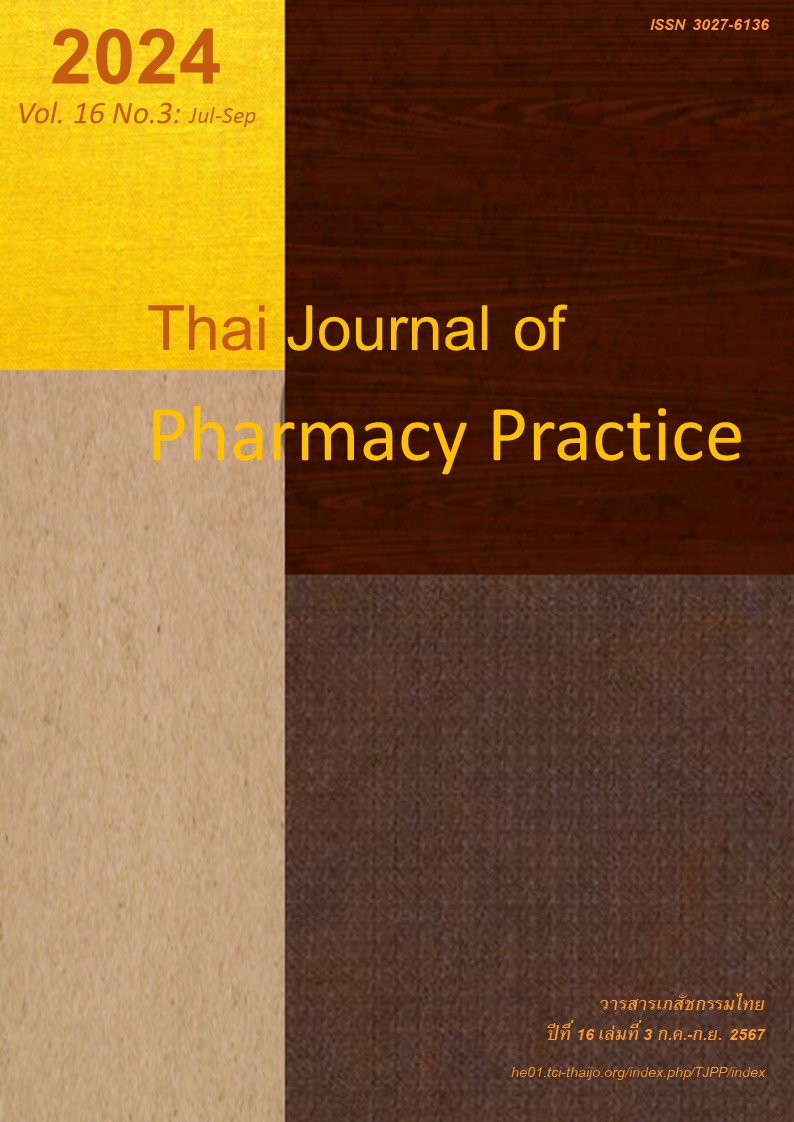การพัฒนากลไกการเฝ้าระวังความปลอดภัยด้านยาและผลิตภัณฑ์สุขภาพ ในอำเภอเวียงแหง จังหวัดเชียงใหม่
Main Article Content
บทคัดย่อ
วัตถุประสงค์: เพื่อพัฒนาและประเมินกลไกการเฝ้าระวังความปลอดภัยด้านยาและผลิตภัณฑ์สุขภาพ ผ่านกระบวนการมีส่วนร่วมของเจ้าหน้าที่ระดับโรงพยาบาลและอาสาสมัครสาธารณสุขประจำหมู่บ้าน (อสม.) วิธีการ: งานวิจัยเชิงปฏิบัติการครั้งนี้ใช้หลักวงจรการบริหารงานคุณภาพ (PDCA) จำนวน 2 รอบในการพัฒนา 2 กลไก ได้แก่ 1) การเฝ้าระวังความปลอดภัยด้านยาเชิงรุกในโรงพยาบาล โดยสนทนากลุ่มในแพทย์ เภสัชกร และพยาบาล การประเมินผลลัพธ์ทำโดยการค้นหาผู้ป่วยที่ได้รับผลกระทบจากยาและผลิตภัณฑ์สุขภาพ และจำนวนการรายงานเหตุการณ์ที่ได้ส่งต่อข้อมูลไปยังชุมชน และ 2) การเฝ้าระวังความปลอดภัยด้านยาเชิงรุกในชุมชน โดยสนทนากลุ่มระหว่างเภสัชกร เจ้าหน้าที่กลุ่มงานบริการด้านปฐมภูมิและองค์รวม ตัวแทน อสม. และสำนักงานสาธารณสุขอำเภอ เพื่อร่วมกันออกแบบแนวปฏิบัติระบบการเฝ้าระวังความปลอดภัยด้านยาในชุมชนซึ่งเชื่อมโยงกับโรงพยาบาล โดยคัดเลือก อสม. จำนวน 30 คนเพื่อพัฒนาทักษะและองค์ความรู้ด้านยาและผลิตภัณฑ์สุขภาพ และให้ทำหน้าที่เป็นผู้เฝ้าระวังฯ ในชุมชน ผลลัพธ์ของกลไกการเฝ้าระวังฯ ประเมินจากจำนวนการเฝ้าระวังยาและผลิตภัณฑ์สุขภาพในชุมชน การค้นหาอาการไม่พึงประสงค์จากยาและผลิตภัณฑ์สุขภาพโดยใช้ตัวส่งสัญญาณ จำนวนข้อมูลที่ได้รับส่งต่อจากโรงพยาบาล ร่วมกับการประเมินความรอบรู้ด้านการใช้ยาอย่างสมเหตุผลของ อสม. ระหว่างก่อน-หลังการนำกลไกการเฝ้าระวังฯ มาใช้ ผลการวิจัย: กลไกการเฝ้าระวังฯ เกิดจากการมีส่วนร่วมของผู้เกี่ยวข้องระดับโรงพยาบาลและชุมชน การพัฒนากลไกทำโดยคัดเลือกกลุ่มอาการไม่พึงประสงค์ที่ควรเฝ้าระวังจากสารสเตียรอยด์ ยากลุ่ม NSAIDs สารไซบูทรามีน และซิลเดนาฟิล เพื่อพัฒนาเครื่องมือตรวจจับอันตรายจากผลิตภัณฑ์กลุ่มเสี่ยงในพื้นที่ และกำหนดช่องทางส่งข้อมูลระหว่างโรงพยาบาลและชุมชน ผ่านแกนนำ อสม. โดยใช้แอพพลิเคชั่นไลน์ อสม. มีคะแนนความรอบรู้ด้านการใช้ยาอย่างสมเหตุผลภายหลังการพัฒนาศักยภาพ เพิ่มขึ้นอย่างมีนัยสำคัญทางสถิติ (P< 0.001) จาก 37.09 ±12.93 เป็น 40.76 ±13.70 (คะแนนเต็ม 52 คะแนน) ผลของกลไกการเฝ้าระวังฯ ทำให้เกิดการส่งต่อประเด็นปัญหาด้วยกระบวนการส่งข้อมูลที่เหมาะกับผู้ปฏิบัติงาน สรุป: การวิเคราะห์ปัญหาและพัฒนากลไกเฝ้าระวังผลิตภัณฑ์สุขภาพ โดยสหสาขาวิชาชีพและภาคีเครือข่ายชุมชนร่วมกับการพัฒนาศักยภาพ อสม. ส่งผลให้เกิดแนวปฏิบัติการค้นหาปัญหา และสามารถส่งต่อข้อมูลการใช้ยาและผลิตภัณฑ์สุขภาพของผู้ป่วยระหว่างโรงพยาบาลและชุมชน เพื่อให้ผู้ป่วยได้รับการดูแลอย่างเหมาะสม และป้องกันอันตรายจากการใช้ผลิตภัณฑ์สุขภาพกลุ่มเสี่ยงได้
Article Details

อนุญาตภายใต้เงื่อนไข Creative Commons Attribution-NonCommercial-NoDerivatives 4.0 International License.
ผลการวิจัยและความคิดเห็นที่ปรากฏในบทความถือเป็นความคิดเห็นและอยู่ในความรับผิดชอบของผู้นิพนธ์ มิใช่ความเห็นหรือความรับผิดชอบของกองบรรณาธิการ หรือคณะเภสัชศาสตร์ มหาวิทยาลัยสงขลานครินทร์ ทั้งนี้ไม่รวมความผิดพลาดอันเกิดจากการพิมพ์ บทความที่ได้รับการเผยแพร่โดยวารสารเภสัชกรรมไทยถือเป็นสิทธิ์ของวารสารฯ
เอกสารอ้างอิง
Health Consumer Protection Program, Chulalongkorn University. Consumer situation 2019 [online]. 2020 [cited Apr 1, 2021]. Available from: www.thaihealth consumer.org/news/consumer_situation2019/
Sukamolson S, Sriviriyanuparp W, Kulsomboon V. Priority, prevalence and geographic distribution of unsafe products in Thailand. Journal of Health Systems Research 2016; 10: 65-79.
Suijaitat S, Suttajit S, Suwanaprom P. Effects of health system complexity on antibiotics use in ethnic group of Maechaem district, Chiang Mai. Thai Journal of Pharmacy Practice. 2020; 12: 1065-77.
Office of Permanent Secretary, Ministry of Public Health. Rational drug use community: RDU community. Nonthaburi: Health Administration Division; 2020.
Kerdsri K, Lerkiatbundit S. Relationship between health literacy and self-protection ability among consumers in health products. Thai Journal of Pharmacy Practice. 2019; 10: 239-48.
Vandenbosch J, Van den Broucke S, Vancorenland S, Avalosse H, Verniest R, Callens M. Health literacy and the use of healthcare services in Belgium. J Epidemiol Community Health 2016; 70: 1032-38.
Berkman ND, Sheridan SL, Donahue KE, Halpern DJ, Crotty K. Low health literacy and health outcomes: an updated systematic review. Ann Intern Med. 2011; 155: 97-107.
Ginggeaw S, Prasertsri N. The relationship between health literacy and health behaviors among older adults who have multi-morbidity. Nursing Journal of Ministry of Public Health 2016; 25: 43-54.
Chuemongkon W, Sukyoo P, Kruetiwa N. The effects of medication counseling on drug compliance in peritoneal dialysis patients at peritoneal dialysis clinic in Nopparat Rajathanee hospital, Bangkok. Isan Journal of Pharmaceutical Sciences 2014; 10: 339-53.
Sawaspanich J. Primary pharmaceutical care ser- vices among patients with chronic kidney disease Kantharawichai hospital, Mahasarakham province. Research and Development Health System Journal. 2014; 7: 57-63.
Wattanakul S, Chidnayee S, Sasow P, Tariya D, Panwarin S, Nitirat P. Rational drug use literacy of village health volunteer. Boromarajonani College of Nursing, Uttaradit Journal. 2020; 12: 72-82.
Phodha T, Maluangnon K, Kanjanarat P, Pumtong S. Development of tool and measurement of rational drug use literacy of Thai people. Nonthaburi: Health System Research Institute; 2021.
Best JW. Research in education. New Jersey: Prentice Hall; 1977.
Phodha T, Maluangnon K, Kanjanarat P, Pumtong S. Rational drug use literacy tool: RDUL. Nonthaburi: Health Systems Research Institute; 2022.
Roma W, Kloyiam S. Thai health literacy survey (THL-S) of Thais aged 15 years and above, 2019. Nonthaburi: Health System Research Institute; 2019.
Angsirisak N, Chuenkitiyanon S, Kongjeera A. The effect of case study approach on rational drug use competency in nursing student at Siam University. Bangkok: Siam University; 2022.
Issarasongkhram M. Self efficacy of health volunteers on health promotion participation for elderly in municipality, Nonthaburi. Journal of the Office of DPC 7 Khon Kaen. 2019; 26: 72-82.
Kaewponthong J, Chotikavatchagul S, Klaydesh P, Chamkorm S. Community management for sustaina bility. Dhammathas Academic Journal 2018; 18: 263-73.
Parinyasutinun U. Community management: con- cepts and theories needing to be reviewed. Modern Management Journal. 2016; 13: 11-22.


